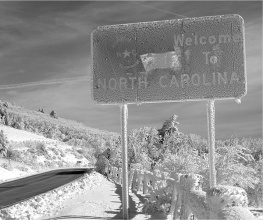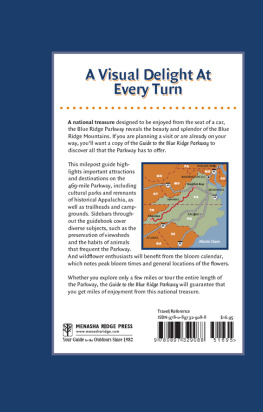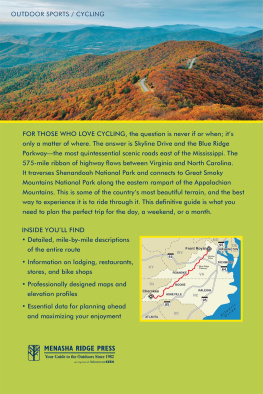Best Easy Day Hikes Series
Best Easy Day Hikes Blue Ridge Parkway
Second Edition
Randy Johnson
Help Us Keep This Guide Up to Date
Every effort has been made by the author and editors to make this guide as accurate and useful as possible. However, many things can change after a guide is publishedtrails are rerouted, regulations change, facilities come under new management, etc.
We would appreciate hearing from you concerning your experiences with this guide and how you feel it could be improved and kept up to date. While we may not be able to respond to all comments and suggestions, well take them to heart and well also make certain to share them with the authors. Please send your comments and suggestions to the following address:
Globe Pequot Press
Reader Response/Editorial Department
P.O. Box 480
Guilford, CT 06437
Or you may e-mail us at:
editorial@GlobePequot.com
Author Randy Johnson is also happy to hear from readers. Please visit his Web site, where youll find multimedia features about hiking and more information about Randy and his books: www.randyjohnsonbooks.com
Thanks for your input, and happy trails!
Copyright 2003, 2010 by Morris Book Publishing LLC
ALL RIGHTS RESERVED. No part of this book may be reproduced or transmitted in any form by any means, electronic or mechanical, including photocopying and recording, or by any information storage and retrieval system, except as may be expressly permitted by the 1976 Copyright Act or in writing from the publisher. Requests for permission should be addressed to Globe Pequot Press, P.O. Box 480, Guilford, Connecticut 06437.
FalconGuides is an imprint of Globe Pequot Press.
Falcon, FalconGuides, and Outfit Your Mind are registered trademarks of Morris Book Publishing LLC.
Maps by Daniel Lloyd Morris Book Publishing LLC
The Library of Congress has cataloged the earlier edition as follows:
Johnson, Randy, 1951
Best easy day hikes, Blue Ridge Parkway / Randy Johnson.1st ed.
p. cm.(A Falcon guide) (Best easy day hikes series)
ISBN 978-0-7627-1069-0
1. HikingBlue Ridge Parkway (N.C. and Va.)Guidebooks. 2. TrailsBlue Ridge Parkway (N.C. and Va.)Guidebooks. 3. Blue Ridge Parkway (N.C. and Va.)Guidebooks. I. Title. II. Series. III. Series: Best easy day hikes series
GV199.42.B65J62 2003
917.55dc21
2003048317
ISBN 978-1-4930-0490-4
The author and Globe Pequot Press assume no liability for accidents happening to, or injuries sustained by, readers who engage in the activities described in this book.
Contents
The Hikes
Introduction
With the 2010 arrival of the Blue Ridge Parkways seventy-fifth anniversary, there has never been a better time to explore what travel writers continually call Americas most scenic highway. Stretches of road elsewhere in the United States may indeed be spectacular, but nothing matches this manicured, uniquely uncommercialized half-a-thousand-mile thoroughfare through the lofty heart of Americas first frontier. Thats what makes the Parkway a globally recognized icon of the American road.
Scenery aside, the recent completion of the Parkways main visitor center in Asheville and the ongoing finalization of the Blue Ridge Music Center near the VirginiaNorth Carolina state line are reminders that the experience just keeps getting richer for visitors. A Parkway vacationtruly tackling the length of the roadway from the southern end of Shenandoah National Park in Virginia to Great Smoky Mountains National Park in North Carolinais a singular experience, a dazzling juncture of earth and sky. Shenandoahs Skyline Drive adds another 100 miles.
Most of the time spent in the Southern mountainsin a car or on footinvolves either going up or coming down. But the Parkway follows almost continually along the cresttruly a skyline traverse.
At the Parkways 45-mile-per-hour speed limit, the drive could be completed in eleven hours. But the point of this book is that it shouldnt. With vistas beckoning from dozens of overlooks, and trails everywhere, this is a motorized wander that couldand surely shouldbe given at least a week. The Parkway is a visual feast of vignettes every step or mile of the way.
The Parkway isnt literally a national park, but it is a unit of the National Park Serviceand the nations most visited one at that. More than half the population of the United States lives within a days drive of the Parkway. Average annual visitation hovers just below 20 million; 2003 set the record at 23.5 million.
Best of all, this national treasure has trails along its entire length, making the Parkway a perfect destination for hikers. Indeed, a drive on this high road is a motorized metaphor for the trail experience itself. The Parkway is an Appalachian Trail for autos. But dont just settle for looking through the windshieldgetting out of the car is a must. Nevertheless, the wonder of this motor trail is that what you see while driving is a lot like what you see in the woods. That includes wildlife.
Be on the road early or late and youll likely have to stop and sit amazed behind the wheel as a herd of deer gambol across the road. Ravens soar with the air currents above evergreen-covered summits. Peregrine falcons, reintroduced at Parkway-adjacent sites since 1984, now nest and dive all along the road. Flocks of wild turkeys, also successfully reintroduced, prefer trailside Parkway meadows.
Theres culture as well. Since our nations earliest westward migrations, the fertile valleys to the east and west of the Blue Ridge Mountains have filled up with farms, towns, and eventually cities. A relative few of those newcomers, among them Scots-Irish and Germans, settled into the very highest elevations of the Blue Ridge and adjacent ranges. Long traditions of music and crafts were thus preserved in these storied hollows. In some ways, Appalachian families were living a pioneering lifestyle long after the West was settled.
Luckily for todays hikers and motorists, early mountain farms and cabinseven a millhave been preserved at key places along the Parkway, and they impart a sense of what life on the heights must have been like. These exhibits incorporate some of the Parkways shorter, tamer trails, but theyre deeply insightful and worth a wander. Noteworthy stops include the Mountain Farm Trail at Humpback Rocks (Milepost 5.8), Trails Cabin at Smart View Picnic Area (Milepost 154.5), the Johnson Farm at Peaks of Otter (Milepost 85.9), and Mabry Mill (Milepost 176.2).
Handcrafts were essential for survival in this land of do without. That rich tradition of crafts comes to life in a variety of places on and adjacent to the Parkway. In North Carolina, dont miss the Northwest Trading Post (Milepost 258.6), the Parkway Craft Center in Moses H. Cone Memorial Park (Milepost 294.0), and the Folk Art Center near Asheville (Milepost 382.0).
The Parkways craft centers and mountain lifestyle exhibits are just the beginning. Skilled crafters often demonstrate their skills at the Parkways various craft centers. Reenactors at the lifestyle exhibits depict the kinds of domestic and commercial activities it took to wrest a living from a harsh climate and primitive facilities. If you make time for these programs, an amazing part of Americas past will come to life for you.
The National Park Service also tries to remind Parkway travelers of the past by leasing lands along the road for farming and other traditional activities. And while you surely will see vacation homes perched in plain sight of the road (Who wouldnt want a perpetual Parkway view?), organizations such as the Blue Ridge Parkway Foundation (336-721-0260; www.brpfoundation.org) and Friends of the Blue Ridge Parkway (704-6878722 or 800-228-7275; www.blueridgefriends.org) purchase land and scenic easements to preserve the Parkways viewshed and update visitor centers and other facilities.
Next page









